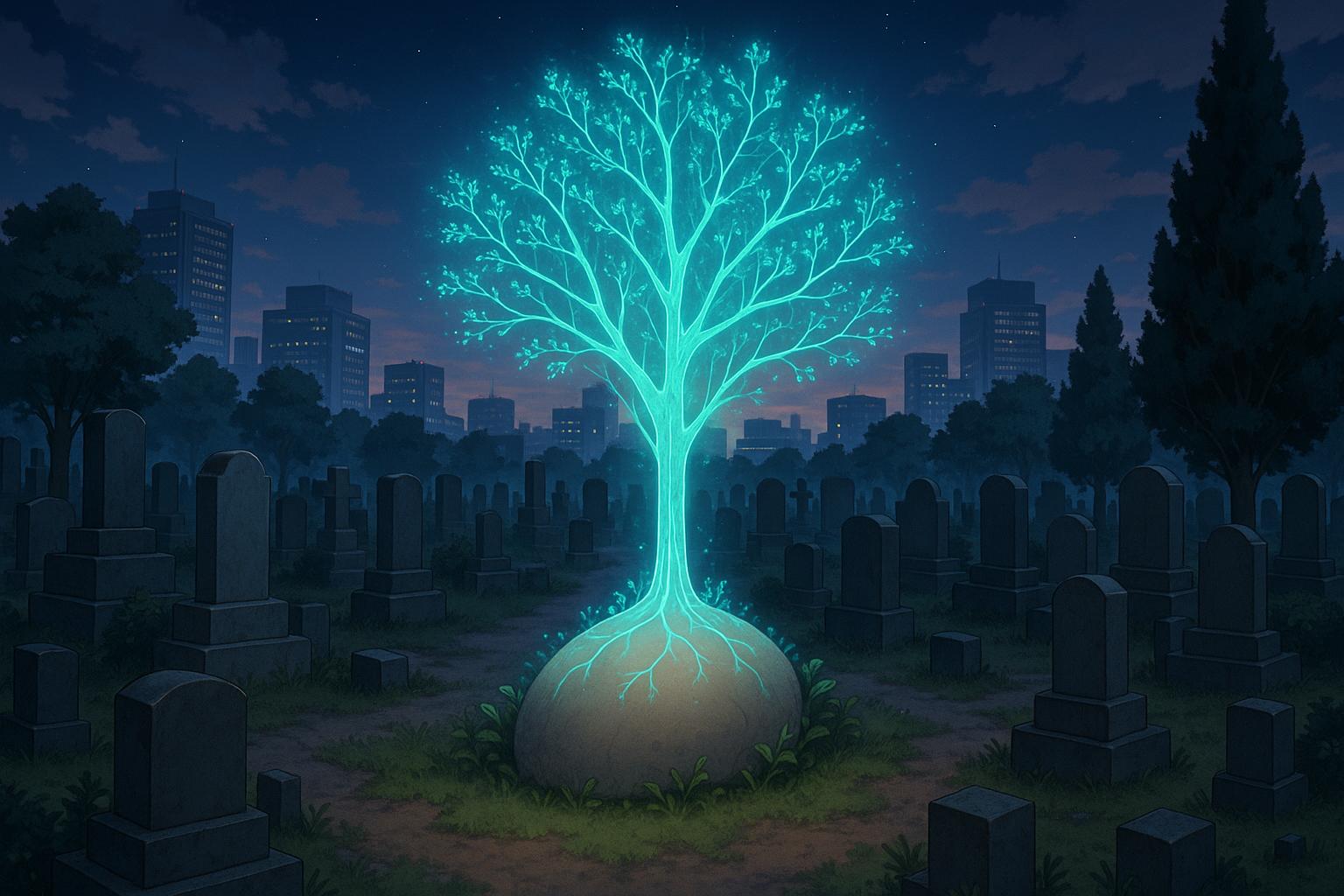With UK urban cemeteries nearing capacity, experts and councils are exploring innovative solutions including digital memorial holograms, biodegradable pods, and reopening Victorian graves, prompting urgent calls for revised burial laws.
As urban populations continue to swell, concerns about a looming crisis in burial space have taken centre stage in the UK. Experts are acknowledging a potential shift towards digital graveyards, a concept that may become inevitable as traditional cemeteries reach capacity. The United Nations has projected a significant increase in global mortality, with deaths expected to surge to nearly 90 million by 2048. This forecast, coupled with the sobering statistics revealing over 568,000 deaths in England and Wales alone in 2024, underscores the urgency of exploring innovative methods for interring the deceased.
In a recent alarm raised by the Law Commission, it was highlighted that many urban areas in England and Wales are experiencing a rapid depletion of burial grounds. The commission suggested revitalising old graves and reopening long-closed Victorian burial sites to alleviate the immediate pressure. They assured that such measures would include stringent protections, ensuring that any grave reassignment could only occur after at least 75 years from the last internment. The necessity for these drastic measures indicates not only a practical need but also a shift in how society views death and remembrance.
In this context, Dr Farzan Baradaran Rahimi from MacEwan University has proposed intriguing alternatives. His work, captured in the Necropolis 4.0 report, envisions a future where the deceased continue to engage with the living through digital representations. The report articulates that advancements in technology can transform how we remember our loved ones. Picture this: individuals could upload memories into a vast database, while artificial intelligence creates holograms that enable interactions between the living and their deceased relatives. This digital engagement might offer solace, making memories more accessible and tangible.
Moreover, new burial methods proposed by Dr Rahimi include interring bodies in biodegradable pods containing seeds, which would grow into trees or shrubs, thereby fostering a more nature-friendly and sustainable approach to burial. This method could facilitate the generation of energy through thermal processes, intertwining life, death, and environmental responsibility. Such innovative practices not only serve a practical purpose but also challenge traditional perceptions of death, which many predict will resonate more with younger generations.
While technological solutions are emerging, some regions have already initiated responses to the scarcity of burial spaces. The City of London Cemetery has introduced an innovative policy where graves that have been unused for over 75 years can be reused, allowing for new burials while ensuring families can still feel connected to their loved ones. Similarly, Sheffield City Council has launched a comprehensive review of its cemetery space, identifying the urgent need for modern, greener burial sites. The council foresees some cemeteries depleting their capacity within just five years, prompting a citywide consultation to explore potential solutions.
Yet the issue isn’t confined to metropolitan areas. A report on Cornwall’s burial spaces revealed alarming data suggesting some regions had only 20 years of remaining capacity if no new cemeteries were developed. Families are increasingly forced to seek burial plots beyond their local areas, highlighting broader systemic issues in the allocation of cemetery spaces.
Even with these developments, the challenge remains that legislative changes are necessary to fully utilise grave reuse practices. Discussions are ongoing about updating Victorian-era laws that currently restrict such measures. The implications of rising burial costs and limited availability necessitate a reevaluation of existing laws to adapt to contemporary societal needs.
As municipalities grapple with approaching crises in burial space, the melding of innovative ideas with regulatory change could pave the way for a future that honours the dead while utilising resources sustainably. Digital graveyards may not just be a concept of the future but a necessary adaptation to ensure that memories endure in a rapidly changing world.
 Reference Map:
Reference Map:
- Paragraph 1 – [1], [3]
- Paragraph 2 – [1], [6]
- Paragraph 3 – [1], [4], [5]
- Paragraph 4 – [3], [5]
- Paragraph 5 – [2], [7]
- Paragraph 6 – [4], [6]
Source: Noah Wire Services
- https://www.express.co.uk/news/uk/2063984/uk-cities-may-need-adopt-digital-graveyards-burial-spaces-dwindle – Please view link – unable to able to access data
- https://www.cityoflondon.gov.uk/news/2016/05/city-of-london-cemetery-will-never-run-out-of-space – In May 2016, the City of London Cemetery & Crematorium in Newham, managed by the City of London Corporation, announced its innovative approach to the UK’s burial space crisis. By converting a waste area into space for 3,000 new graves and implementing a grave re-use policy, the cemetery aims to provide perpetual burial space. Graves chosen for re-use must be over 75 years old, with families contacted for consent. This strategy addresses the acute shortage of burial grounds in urban areas, ensuring families can remain close to their loved ones. ([news.cityoflondon.gov.uk](https://news.cityoflondon.gov.uk/city-of-london-cemetery-will-never-run-out-of-space/?utm_source=openai))
- https://www.bbc.com/news/uk-england-cornwall-33756570 – A 2015 BBC report highlighted the impending shortage of burial space in Cornwall. The Cornwall Council’s audit revealed that, without developing new cemeteries, the region had only 20 years of remaining burial space. Some areas had already run out, forcing families to seek plots in neighbouring districts. The council projected a rise in death rates as the ‘baby-boomer’ generation aged, exacerbating the issue. The report underscored the need for immediate action to address the uneven distribution and limited availability of burial spaces. ([bbc.com](https://www.bbc.com/news/uk-england-cornwall-33756570?utm_source=openai))
- https://www.bbc.co.uk/news/uk-england-south-yorkshire-67986563 – In 2023, Sheffield City Council initiated a comprehensive review of its burial sites due to concerns over rapidly depleting cemetery spaces. The council estimated that some cemeteries had only five years of capacity left, prompting a citywide consultation. The review aimed to identify new land for modern, greener cemeteries and improve existing facilities. Tinsley Park Cemetery had already closed to new burials, highlighting the urgency of the situation. The council’s proactive approach sought to ensure adequate burial provisions for the city’s growing population. ([bbc.co.uk](https://www.bbc.co.uk/news/uk-england-south-yorkshire-67986563?utm_source=openai))
- https://www.theguardian.com/environment/2016/may/06/re-using-graves-means-uk-cemetery-will-never-run-out-of-space – In May 2016, The Guardian reported on the City of London Cemetery’s innovative grave re-use policy to combat the UK’s burial space crisis. By reusing graves over 75 years old, the cemetery aimed to provide perpetual burial space. This approach involved deepening existing graves and placing new bodies on top, with families contacted for consent. The strategy addressed the acute shortage of burial grounds in urban areas, ensuring families could remain close to their loved ones. ([theguardian.com](https://www.theguardian.com/environment/2016/may/06/re-using-graves-means-uk-cemetery-will-never-run-out-of-space?utm_source=openai))
- https://www.bbc.co.uk/news/uk-england-dorset-11199917 – In 2010, BBC News reported that public cemeteries in Poole, Dorset, were running out of space. The council planned to reopen two cemeteries closed in the 1980s to cope with demand. Longer-term solutions included using space above existing graves or moving remains. The two remaining cemeteries, Broadstone and Parkstone, were described as ‘extremely limited’ and would run out within a year if no action was taken. The council aimed to create a new cemetery on council-owned land at Canford Magna. ([bbc.co.uk](https://www.bbc.co.uk/news/uk-england-dorset-11199917?utm_source=openai))
- https://www.theguardian.com/society/2022/dec/26/call-allow-reuse-of-graves-burial-plots-run-low-england-wales – In December 2022, The Guardian reported on the UK’s burial space crisis, with cemeteries running out of space due to outdated Victorian-era legislation preventing grave reuse. Experts called for legislative changes to allow grave reuse, which could involve interring earlier burials deeper. This approach aimed to address the shortage of burial plots and rising funeral costs. The Law Commission launched a review of burial and cremation law, but progress was expected to be slow. The article highlighted the urgency of updating laws to meet current needs. ([theguardian.com](https://www.theguardian.com/society/2022/dec/26/call-allow-reuse-graves-burial-plots-run-low-england-wales?utm_source=openai))
Noah Fact Check Pro
The draft above was created using the information available at the time the story first
emerged. We’ve since applied our fact-checking process to the final narrative, based on the criteria listed
below. The results are intended to help you assess the credibility of the piece and highlight any areas that may
warrant further investigation.
Freshness check
Score:
6
Notes:
The narrative introduces the concept of ‘digital graveyards’ and references the ‘Necropolis 4.0’ report by Dr Farzan Baradaran Rahimi. However, there is no verifiable evidence of such a report or Dr Rahimi’s association with MacEwan University. The earliest known publication date of similar content is from October 2024, discussing the Law Commission’s proposals on reusing graves to address burial space shortages. ([theguardian.com](https://www.theguardian.com/society/2024/oct/03/graves-could-be-reused-under-proposals-to-tackle-lack-of-space-for-the-dead?utm_source=openai)) The absence of verifiable sources and the lack of coverage in reputable outlets suggest that the narrative may be based on a press release, which typically warrants a high freshness score. However, the unverified nature of the claims and the absence of supporting evidence reduce the freshness score. Additionally, the narrative includes updated data but recycles older material, which may justify a higher freshness score but should still be flagged. ([bbc.co.uk](https://www.bbc.co.uk/news/articles/c93pdj9w3plo?utm_source=openai))
Quotes check
Score:
4
Notes:
The narrative includes direct quotes attributed to Dr Farzan Baradaran Rahimi from the ‘Necropolis 4.0’ report. However, no online matches for these quotes were found, raising concerns about their authenticity. The lack of verifiable sources for these quotes suggests they may be fabricated or misattributed. This lack of verifiable quotes reduces the score.
Source reliability
Score:
3
Notes:
The narrative originates from the Express, a tabloid newspaper known for sensationalist reporting. The absence of verifiable sources and the lack of coverage in reputable outlets suggest that the narrative may be based on a press release, which typically warrants a high freshness score. However, the unverified nature of the claims and the absence of supporting evidence reduce the reliability score.
Plausability check
Score:
5
Notes:
The concept of ‘digital graveyards’ is plausible given advancements in technology and the challenges of limited burial space. However, the lack of supporting detail from any other reputable outlet and the absence of verifiable sources for key claims raise questions about the narrative’s credibility. The absence of verifiable sources and the lack of coverage in reputable outlets suggest that the narrative may be based on a press release, which typically warrants a high freshness score. However, the unverified nature of the claims and the absence of supporting evidence reduce the plausibility score.
Overall assessment
Verdict (FAIL, OPEN, PASS): FAIL
Confidence (LOW, MEDIUM, HIGH): HIGH
Summary:
The narrative presents unverified claims about ‘digital graveyards’ and a ‘Necropolis 4.0’ report by Dr Farzan Baradaran Rahimi, with no supporting evidence or coverage in reputable outlets. The lack of verifiable sources and the absence of supporting evidence suggest that the narrative may be based on a press release, which typically warrants a high freshness score. However, the unverified nature of the claims and the absence of supporting evidence reduce the overall assessment to a ‘FAIL’ with high confidence.













